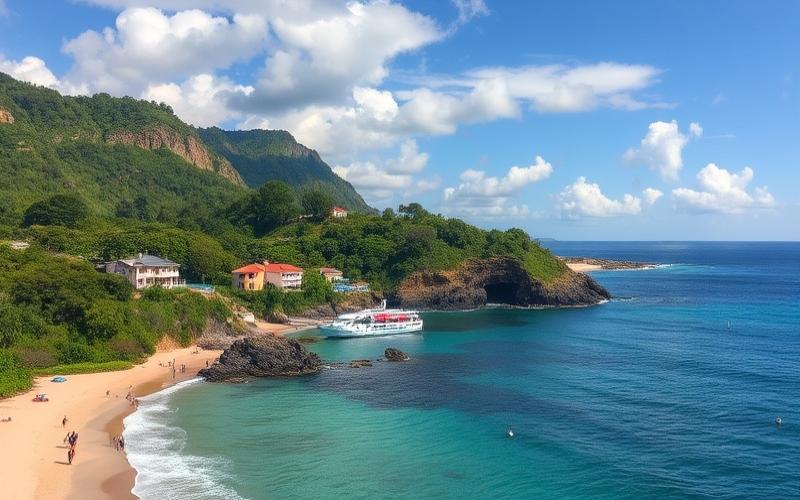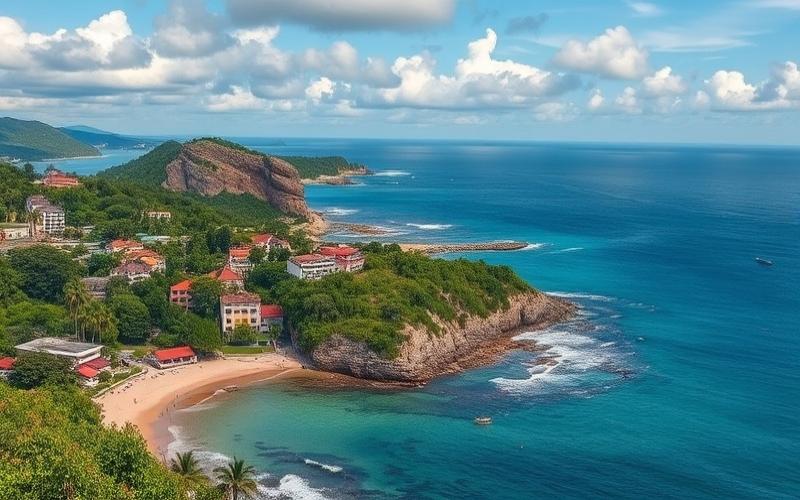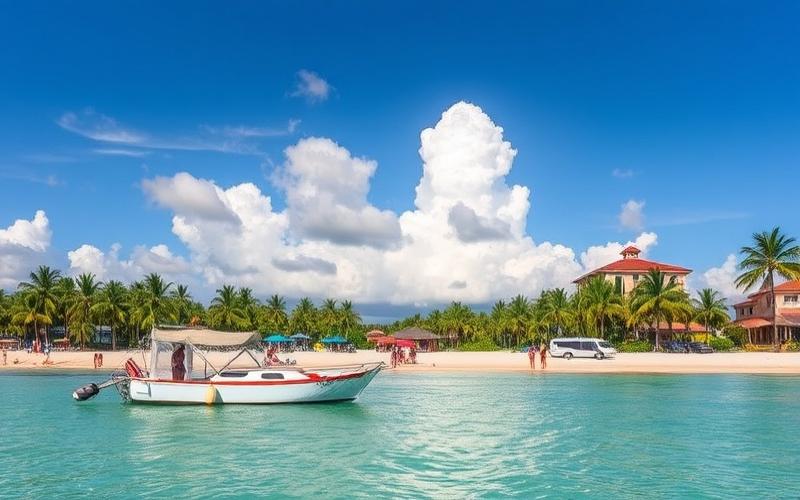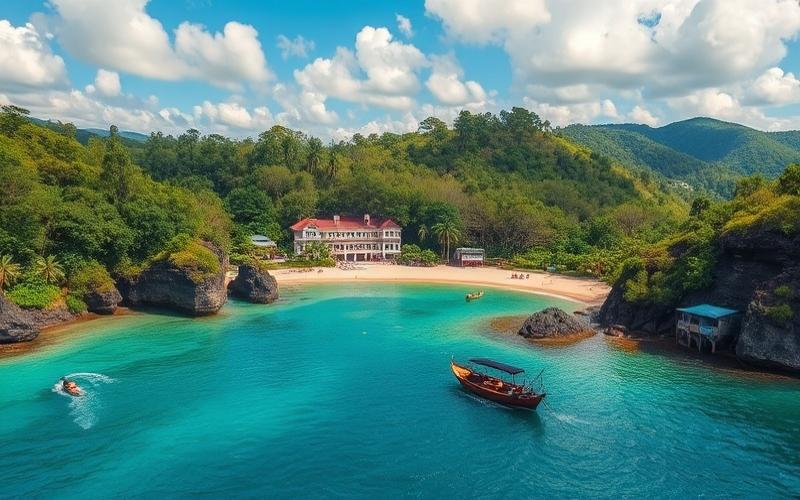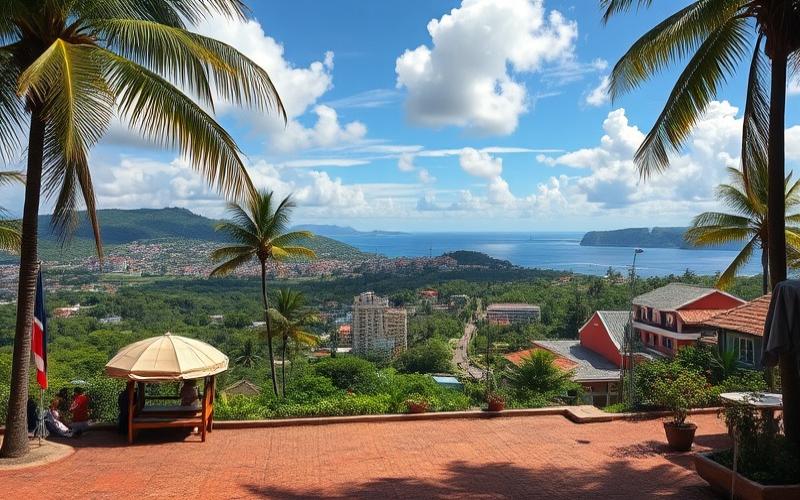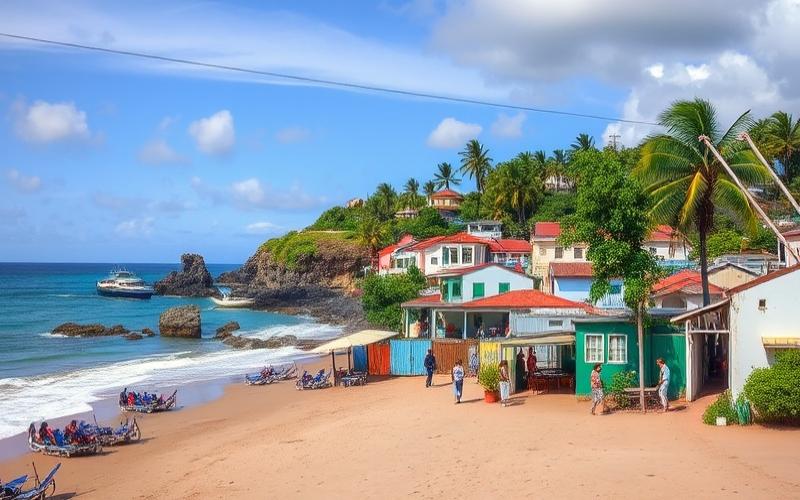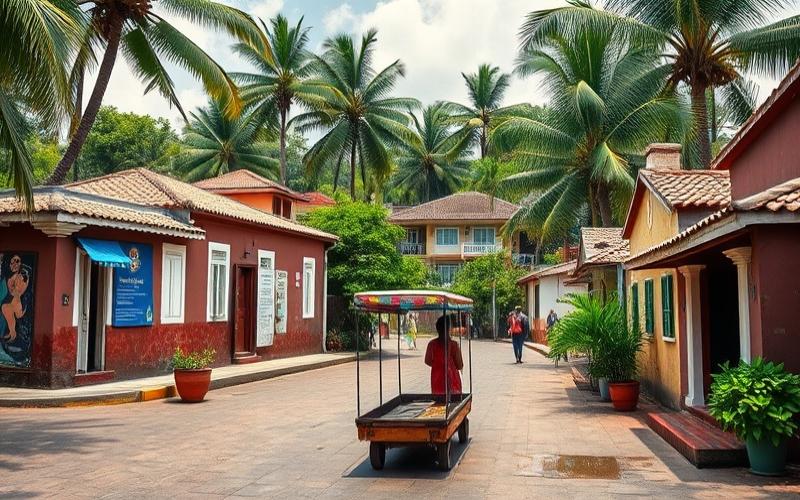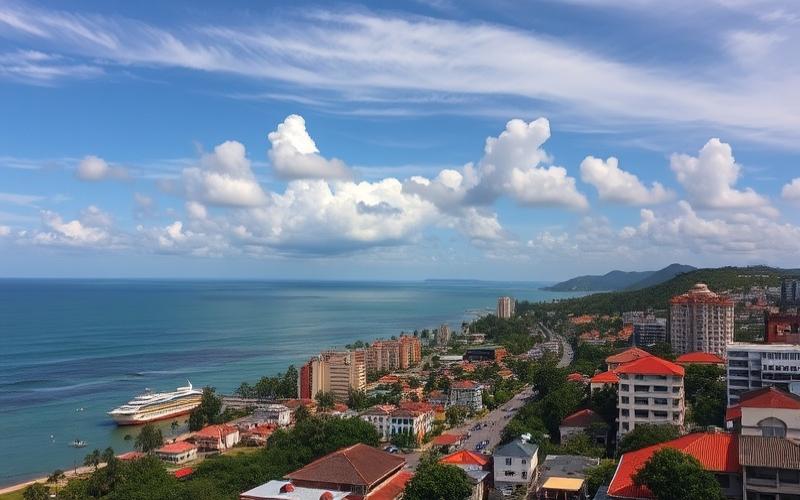
 Published on and written by Cyril Jarnias
Published on and written by Cyril Jarnias
Micro-Apartments: An Innovative Solution in the Dominican Republic
Faced with rising living costs and urban densification, micro-apartments are emerging as an innovative and economical solution for residents of the Dominican Republic. More than just an architectural trend, these compact living spaces meet the needs of young professionals, students, and low-income individuals seeking affordable housing.
By optimizing every available square meter, these minimalist apartments allow residents to live in desirable neighborhoods while maintaining good value for money. Through examining the benefits, challenges, and future prospects, this article explores how these ingenious habitats are reinventing living in small spaces while addressing contemporary economic imperatives.
Good to Know:
Micro-apartments are particularly suited to urban areas where space is limited and rents are high.
Microliving: An Emerging Trend in the Dominican Republic
Microliving in the Dominican Republic is driven by a combination of economic and social factors, primarily the growing urbanization of major cities like Santo Domingo and Punta Cana, along with the pressing demand for affordable housing. With rising urban living costs and a steady influx of newcomers seeking economic or tourism opportunities, micro-apartments offer an accessible solution for a young or mobile population.
Typical characteristics of micro-apartments in the country include:
- Reduced square footage, typically between 194 and 323 square feet.
- Innovative design maximizing every square foot with modular furniture, built-in storage, and multifunctional spaces.
- Prime locations within dynamic urban areas, close to business centers, shops, and public transportation.
- Modern finishes promoting natural light (large picture windows) and energy efficiency.
| Characteristic | Description |
|---|---|
| Size | 194 to 323 sq ft |
| Design | Multifunctional spaces, built-in furniture |
| Location | Central urban neighborhoods |
| Target Audience | Young professionals, expatriates, investors |
The rise of microliving is gradually transforming the local real estate market:
- Increasing number of new real estate projects dedicated to small housing units in strategic areas.
- Growth in flexible rental offerings to meet seasonal (tourism) or permanent (urban workers) demand.
- Recent examples: launch of compact buildings in expanding neighborhoods concentrated with shops and restaurants.
Public reaction remains mixed:
- Young professionals appreciate urban proximity coupled with reasonable pricing.
- Some traditional residents express concerns about long-term minimalist comfort.
The main challenges associated with microliving are:
- Limited comfort: restricted space potentially affecting daily quality of life for certain family profiles or those seeking more privacy.
- Sometimes inadequate government regulations: lack of clear standards on minimum permitted dimensions or habitability can hinder innovative projects.
List of Major Challenges:
- Lack of personal space
- Risk of social isolation
- Difficulty adapting local regulations to new housing forms
- Cultural acceptance still evolving
Thus, microliving fits into a local dynamic where it addresses urgent needs related to rapid urbanization while raising its own questions about sustainable residential comfort.
Good to Know:
Microliving in the Dominican Republic is driven by rapid urbanization and the need for affordable housing, particularly attracting young professionals and students. Micro-apartments, typically ranging from 215 to 430 square feet, stand out through compact and innovative designs that maximize space with multifunctional furniture and clever storage solutions. Often located in dynamic urban areas like Santo Domingo, these residences follow a global trend and are beginning to reshape the local real estate market, with recent projects such as “Smart Studio” complexes generating growing interest. However, challenges remain, particularly regarding long-term living comfort and regulations insufficiently adapted to this new housing form. Improved government policies could nevertheless encourage broader microliving development and address population concerns.
Economic Benefits of Micro-Apartments for Investors
Growing Demand for Affordable Housing in Urban Centers
Population growth, rapid urbanization, and rising living costs in major Dominican cities (Santo Domingo, Santiago) are driving demand for affordable housing.
Micro-apartments, by offering more accessible rents, meet the expectations of young professionals, students, and expatriate workers seeking economical solutions in the heart of urban centers.
Potential Investment Profitability
- The Dominican rental market remains attractive, with high occupancy rates for small units due to strong demand.
- Investors benefit from the possibility of short or long-term rentals, thus maximizing rental yield according to seasonality or target clientele.
- Local market studies show that micro-apartments’ gross yield can exceed that of standard apartments, particularly in central neighborhoods or near tourist areas.
Construction and Maintenance Cost Comparison
| Criterion | Micro-Apartments | Standard Apartments |
|---|---|---|
| Cost per sq ft | Higher | Lower |
| Total unit cost | Less expensive | More expensive |
| Maintenance | Simplified | More complex |
| Fees | Reduced | Higher |
The reduced size of micro-apartments allows for lower construction costs per unit.
Routine maintenance (cleaning, repairs) is less costly, optimizing profit margins, especially in intensive rental management.
Faster Return on Investment and Positive Cash Flow
Micro-apartments, due to their lower purchase price and strong rental demand, allow for quicker recovery of invested capital.
High turnover rates and easy reletting ensure positive cash flow, even during temporary vacancies.
Real Estate Portfolio Diversification
Investing in micro-apartments allows risk distribution across multiple units rather than concentrating it on a single large property.
This strategy offers better resilience against market fluctuations and facilitates adjustment of rental offerings according to demand.
Government Policy Development and Tax Incentives
The Dominican government encourages foreign real estate investment, with equal rights for local and international investors.
Tax incentives exist for certain types of real estate projects, including those promoting access to affordable housing.
Investors can benefit from attractive residency programs, facilitating their stay and administrative procedures.
Expert Testimonials and Perceptions
“The Dominican Republic, with its open policies and dynamic market, is attracting more and more international investors drawn by the profitability and security of the real estate sector. Micro-apartments meet a real demand and represent an opportunity to diversify one’s portfolio while minimizing risks.”
“For young professionals and expatriates, micro-apartments represent a modern and economical solution, highly sought after in Dominican urban centers.”
Summary of Investor Benefits:
- Higher profitability due to strong rental demand.
- Optimized management costs (construction, maintenance, fees).
- Fast return on investment and regular cash flow.
- Diversification and risk reduction.
- Easier access for foreigners and advantageous tax environment.
- Capital appreciation potential in a growing urban market.
Good to Know:
In the Dominican Republic, demand for affordable housing in urban centers is growing rapidly, making micro-apartments particularly attractive to investors. These units offer notable potential profitability, as demonstrated by case studies showing higher profit margins compared to standard apartments, due to reduced construction and maintenance costs. Micro-apartments enable quick return on investment and positive cash flow, while facilitating real estate portfolio diversification and risk reduction. Furthermore, prospects of favorable government policies or tax incentives for such projects could further enhance their appeal. Dominican real estate market experts confirm this trend, highlighting the growth of this segment as a viable and adaptive investment opportunity.
Yield and Profitability: Investing in Small Spaces in the Dominican Republic
Average Micro-Apartment Yields by Region
| Region | Gross Rental Yield | High Season Occupancy Rate | Estimated Net Monthly Rent (Studio/1 Bedroom) |
|---|---|---|---|
| Punta Cana | 6 to 10% | 80% and above | $1,200 to $1,800 |
| Las Terrenas | 7 to 10% | 80% | $1,500 |
| Santo Domingo | 6 to 8% | 65-75% | $1,000 to $1,500 |
| Cabarete | 8 to 10% | 80% | $1,200 to $1,700 |
The national average gross rental yield in early 2025 is estimated at 7.12% (rising), with peaks of 10% for the best-located and well-managed properties.
Current Local Real Estate Market Trends
- Rapid urbanization of centers like Santo Domingo and Santiago, with influx of young professionals and digital nomads seeking compact, affordable housing.
- Growing appeal of short-term rentals in tourist areas (Punta Cana, Las Terrenas, Cabarete), boosting small space profitability.
- Development of new projects for micro-apartments and hotel complexes incorporating studios for international investors.
- Steady increase in purchase prices (+5 to 8% annually for some micro-apartments in beachfront areas or near attractive urban centers).
Tax Benefits for Investors
- Partial or full exemption from property tax (IPI) for properties below certain valuation thresholds.
- Capital gains tax exemption upon resale in certain cases (under conditions).
- No wealth tax.
- Moderate notary and registration fees (approximately 3-4% of transaction amount).
- Some projects benefit from CONFOTUR law, offering up to 15 years of tax exemption on rental income and resale.
Maintenance and Operating Costs Associated with Small Spaces
- Homeowners association fees generally low ($50-150/month for a studio, depending on included services).
- Simplified maintenance (cleaning, minor repairs), average annual cost $300-600.
- Rental management: 10-20% of gross income if delegated to an agency.
- Insurance: $100-200/year.
| Expense Category | Estimated Annual Cost (Studio) |
|---|---|
| Homeowners association fees | $600 to $1,800 |
| Maintenance and repairs | $300 to $600 |
| Insurance | $100 to $200 |
| Rental management | $1,500 to $2,500 (if delegated) |
Demand Growth Prospects
- Accelerated urbanization: internal migration toward urban centers, strong demand for compact housing.
- Growing tourism: over 7 million tourists/year in Punta Cana, development of remote work and digital nomadism.
- Accessibility: micro-apartments more affordable to purchase, broadening investor and tenant base.
- International trend: search for flexibility, mobility, and budget optimization among young professionals.
Successful Project Examples
- Central Park, Las Terrenas: micro-apartments at $75,000, 70% annual occupancy rate, net profitability over 8%.
- Serena Village, Punta Cana: studios sold around $65,000, 8-10% net rental yield, simplified management, popular with tourists and young professionals.
- Zona Colonial Studios, Santo Domingo: targeting expatriates, high occupancy rate, management by hotel operators, average net yield of 7-8%.
Profitability Assessment and Strategies to Maximize Return on Investment
Assessment steps:
- Calculate gross and net yield: compare potential annual rent and all expenses (HOA fees, maintenance, taxes, management).
- Analyze average occupancy rate according to location and seasonality.
- Study resale price trends in target area.
- Consider specific project taxation (CONFOTUR benefits, IPI exemption thresholds, etc.).
- Benchmarking: compare with similar projects in the same region.
Recommended strategies:
- Choose premium locations: proximity to beaches, tourist centers, or dynamic business districts.
- Invest in complexes with integrated rental management: time savings, better rental visibility.
- Opt for flexible arrangements: seasonal rentals (Airbnb, Booking) or long-term leases depending on period.
- Enhance rental offerings: provide additional services (cleaning, high-speed wifi, concierge).
- Diversify portfolio: mix different formats (studios, 1 bedroom) and different locations to smooth risk.
⎋ Micro-apartments in the Dominican Republic offer an attractive risk/return profile, driven by tourism and urban growth, and supported by an incentive tax framework for savvy investors.
Good to Know:
Investing in micro-apartments in the Dominican Republic offers attractive yield rates, with averages ranging from 6-9% depending on region, particularly in metropolitan areas like Santo Domingo where demand is strong. Rapid urbanization and growing need for affordable housing increase the appeal of these small spaces. Tax benefits, such as tax reductions for green construction, make these investments even more attractive, while maintenance costs remain modest. Successful projects, like those located in La Romana, illustrate a profitable model offering stable rents and low vacancy rates. To optimize their investment, potential investors should carefully examine key performance indicators such as occupancy rates and management fees, while considering long-term rental strategies to maximize income.
Challenges and Considerations for Investing in Studios in the Dominican Republic
Economic factors influencing studio investment in the Dominican Republic are multiple, with direct implications for sector profitability and growth potential.
Key Economic Factors:
- Construction costs: Prices remain competitive compared to other Caribbean destinations, though costs can vary by location (urban or tourist area).
- Local real estate market prices:
- Santo Domingo (downtown): $1,498/㎡
- Punta Cana: $2,695/㎡
- Las Terrenas: $1,694/㎡
- Puerto Plata: ~$1,110/㎡
Examples of studios for sale:
| Location | Price ($) | Area (sq ft) |
|---|---|---|
| Sosua | ~$119,000 | N/A |
| Cap Cana | ~$282,000 | N/A |
| Perla Marina | ~$78,500 | 463 |
- Rental profitability potential:
- Average gross yield around 8% in tourist areas.
- Constant tourism growth supports seasonal and annual rental demand.
Regulatory and Legal Aspects to Consider:
- Foreign ownership law:
- Foreigners can freely purchase real estate in the Dominican Republic.
- Real estate taxation:
- Rental income subject to 27% local tax, with possible deductions for property-related expenses.
- Specific tax benefits for certain investments through CONFOTUR regime.
Infrastructure Challenges and Access to Public Services:
Variable quality by region for access to drinking water, stable electricity, and high-speed internet.
In some rural or emerging tourist areas, power outages or limited access to public services can hinder real estate appreciation.
Socio-Cultural Considerations Impacting Demand:
Local preferences: Residents generally prefer more spacious family apartments. However, a growing segment of young professional or retired expatriates seek modern studios or micro-apartments near urban or beachfront amenities.
Brief list of buyer/tenant profiles:
- European and North American expatriates
- Young local professionals attracted to downtown areas
- Investors focused on short-term rentals
Potential Impact of Micro-Apartments on Local Market:
| Aspect | Positive Effects | Potential Risks |
|---|---|---|
| Urban Planning | Land optimization | Excessive densification |
| Accessibility | Affordable supply | Price per sq ft pressure |
| Community Life | Social dynamism | Sociological evolution |
Micro-apartments promote new urban dynamics through their financial accessibility; they also contribute to renewing the housing stock. However, their multiplication can lead to a general increase in cost per square foot in some desirable neighborhoods and significantly transform the local social fabric.
Good to Know:
Investing in studios in the Dominican Republic requires particular attention to several economic and regulatory factors. Construction costs vary by region, but it’s essential to assess real estate market prices, which are growing rapidly, to anticipate profitability potential. Local laws on foreign ownership are relatively favorable; nevertheless, understanding local taxation and the property transfer process is crucial to avoid legal complications. Challenges sometimes include deficient infrastructure and variable access to public services, key elements to consider when selecting location. Cultural preferences also influence demand: micro-apartments mainly attract expatriates and young local professionals seeking economical solutions. Thus, any investor must weigh the potential impact of these small units on the local community, considering both economic benefits and social changes in the real estate market.
Disclaimer: The information provided on this website is for informational purposes only and does not constitute financial, legal, or professional advice. We encourage you to consult qualified experts before making any investment, real estate, or expatriation decisions. Although we strive to maintain up-to-date and accurate information, we do not guarantee the completeness, accuracy, or timeliness of the proposed content. As investment and expatriation involve risks, we disclaim any liability for potential losses or damages arising from the use of this site. Your use of this site confirms your acceptance of these terms and your understanding of the associated risks.













